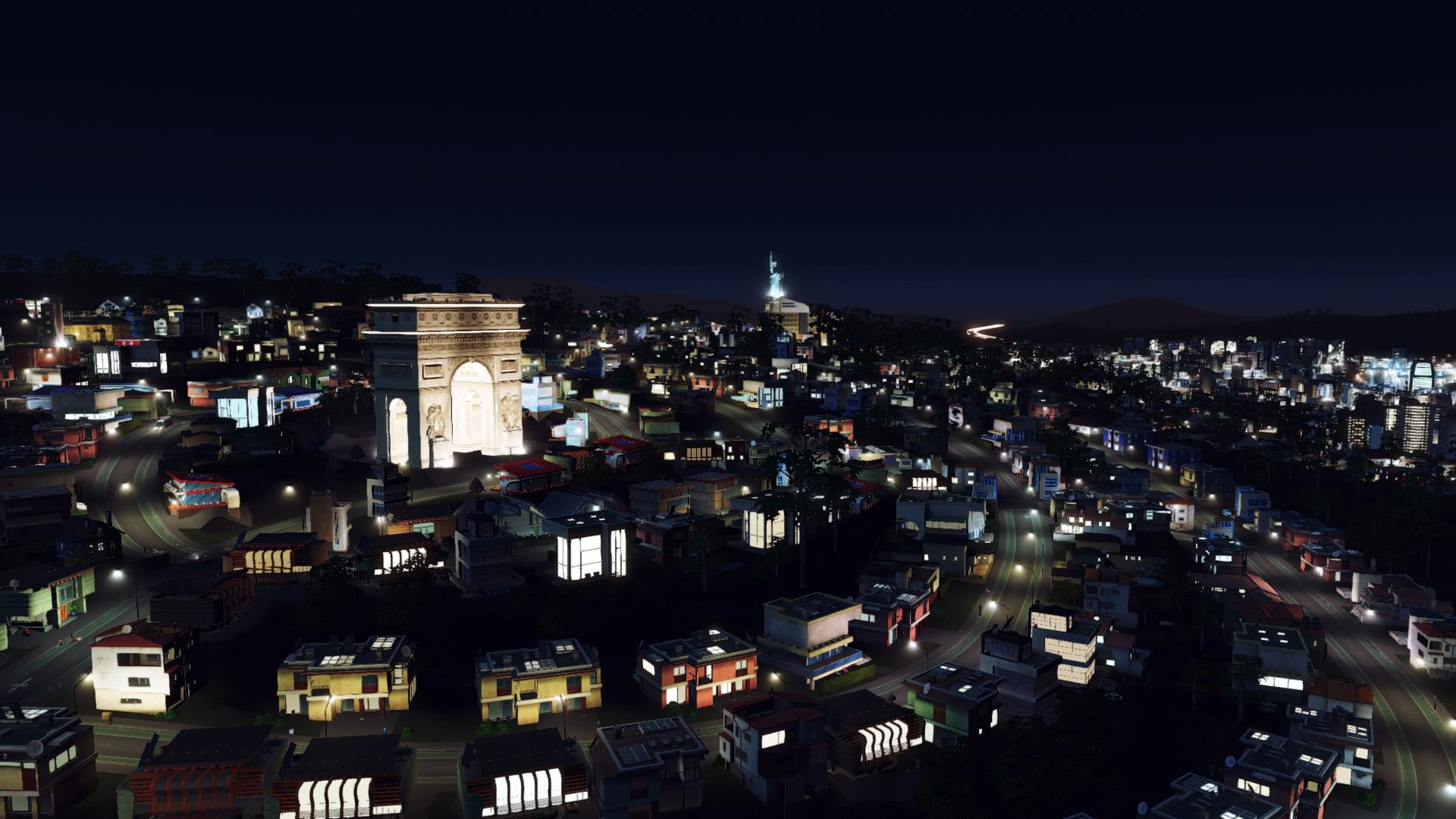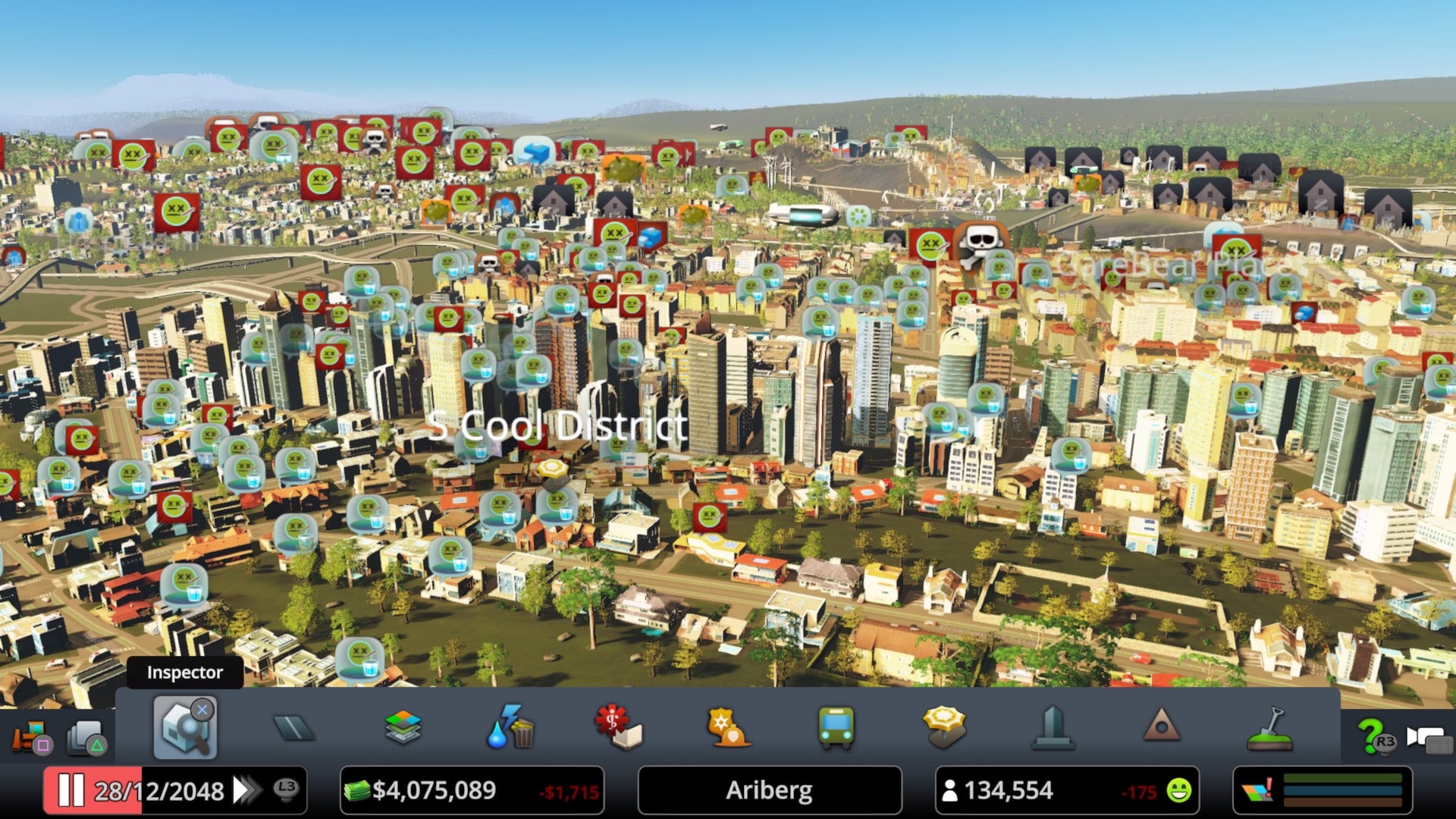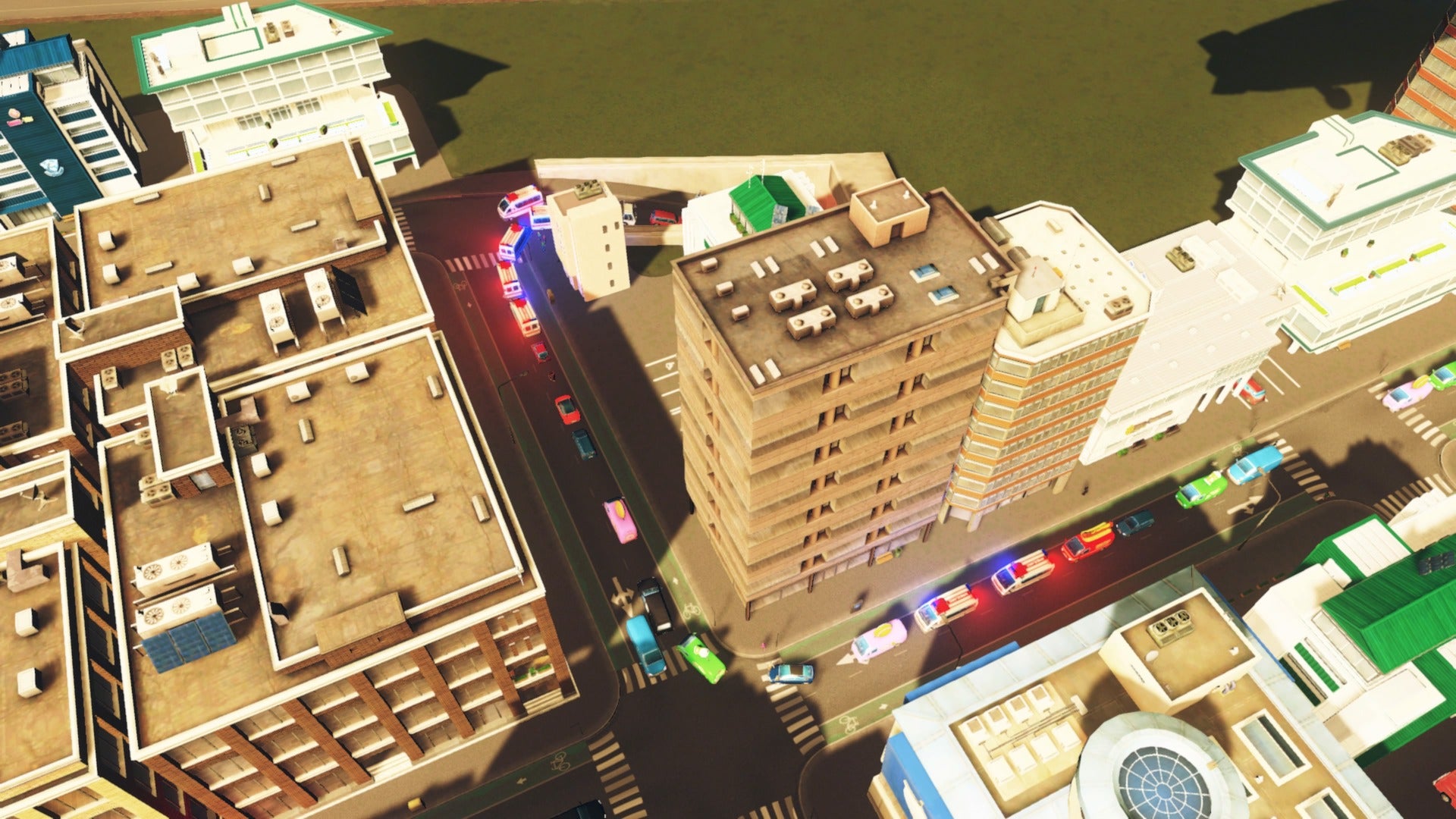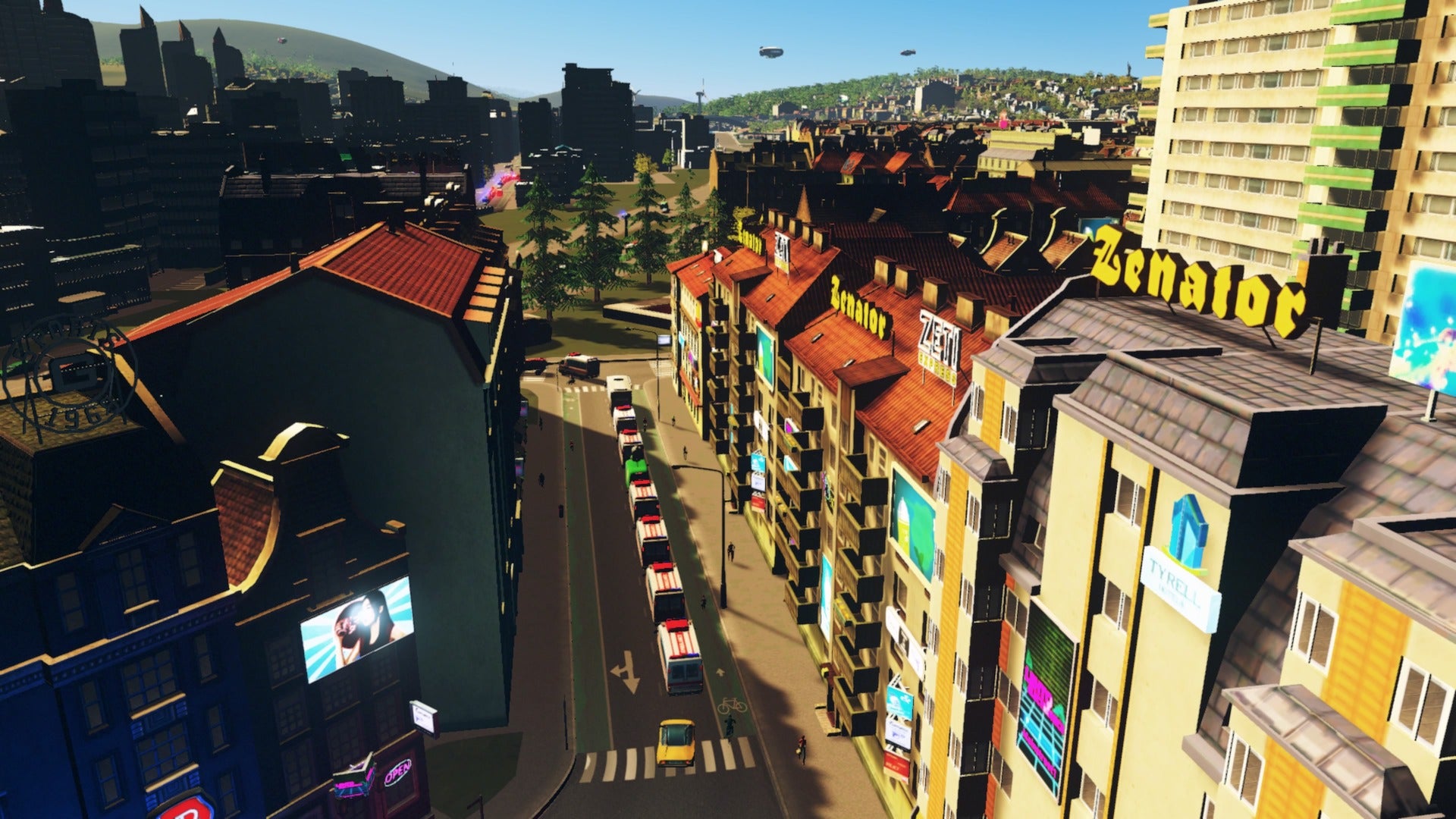To all of the people who live in Ariberg, my Cities: Skylines metropolis, I am truly sorry.
My intentions were pure, I swear. Like many other wide-eyed millennials, I set out to enact meaningful change, to prove that American cities needn’t rely so heavily on a car-centric framework. But in the process of trying to do some good, I really screwed up: I sparked a full-blown pandemic.
Cities: Skylines is a city-builder game widely considered as a high-water mark for the genre. First released in 2015, Cities was a cool bath for wannabe city planners burned by EA’s disastrous 2013 SimCity reboot. Post-release updates have since ironed out any glaring wrinkles. The modding community, too, has gone all in on Cities, introducing graphical improvements, one delicious Google Maps-esque viewing tool, several new architectural facades, and various, countless fixes that just generally made the game more user-friendly.
The allure of Cities: Skylines isn’t just a result of its terrific city-builder bona fides (though that’s very much a part of it). It comes from how deep in the weeds you can get in micro-managing every square inch of your realm. You can zone various areas as commercial, residential, or industrial districts. (Sorry, NUMTOTs, no mixed-use zoning in Cities.) You can designate districts, rename them whatever you want, and tweak the jurisdictional tax rates right on down to the percentage point. You can impose limits on density, manifest new parks out of thin air, construct hospitals and other essential social services, level highways, widen roads, build metro lines, build bus stops, taxi stands, or train stations, and even terraform the surrounding geography. And you can do all of this without having to bend to the frustrating whims of a community board.
You can, in other words, play god-king in your own personal domain of zoning laws and civil ordinances. So the question at the core of Cities: Skylines isn’t just “What does the city of your dreams look like?” It’s also, “Were you a god, what would you do?”
Me? Oh, easy. Step one: Banish all the cars. That might sound patently ridiculous, but it’s really quite normal.
“You don’t have to actually imagine the ideal city without cars in it,” Doug Gordon, a co-host of The War on Cars podcast, recently told me over a video call. “You can just think of the kinds of places that people like to go to on vacation, whether that’s Paris or Amsterdam or Main Street U.S.A. in Disney World. Nobody goes to those places and says, ‘This is wonderful! But you know what would make it better? A bunch of cars.’”
Let’s run down some facts. (Heads up: Things are about to get dour.) In 2019, according to the National Safety Council, an estimated 38,800 people were killed as a result of car crashes in the United States. In addition, more than 4 million people suffered injuries serious enough to warrant medical attention. These are staggering figures, and they recur at roughly the same severity year after year after year. By the numbers, few innovations are more singularly harmful to the continued prospect of human life than the automobile.
It’s not just what you can see and calculate, either. Cars can impact health in more insidious, but no less serious, ways. For instance, the noise pollution they generate — be that from interstate highways or midtown thoroughfares — can cause cortisol levels to spike, essentially putting your brain into a constant state of “fight or flight.” You can imagine how bad that is for mental wellbeing. According to the World Health Organisation (as cited by the European Environment Agency), noise is the second-highest environmental cause of health problems, right behind air pollution.
Cars are a spatial disaster, too. Gordon calls cars a “geometry problem,” and noted how “they take up a lot of space that cities generally don’t have. You have to park them for the majority of the time that they’re not being used, which is the majority of the time.” A famous graphic by the venerable traffic researcher Claes Tingvall illustrates just how much space we willingly give over to cars without even realising it. When you take away the roads, and consign people to the pedestrian areas, the footpaths and crosswalks, how much space is left for people? Spoiler alert: Not much!
And then there’s the environment. Even if you think that hybrids are game-changing (they’re not) or that electric cars will save us (they won’t), cars have already wrought significant harm to our planet, and will continue to do so as long as they’re the primary mode of transportation.
So, yeah. Cars! They’re bad. Can you blame me for wanting to get as many off my streets as I could?
Cities: Skylines does not make it easy. For one thing, you can’t flip a switch that says “no cars.” The game — like many facets of modern society — is structured around the automobile. All of your buildings have to exist roadside, and all of those roads will fill up with vehicles, thanks to how the game fundamentally works. (To a certain degree, this makes sense. Emergency vehicles like fire trucks need roads to get from place to place. Ambulances, which you’ll soon come to know as the bane of Ariberg’s prosperity, also need roads.) You cannot do away with cars entirely. But there’s no reason not to minimise their use.
“I see mobility as a Swiss Army knife,” Gordon told me. “Every now and then, when you’re camping, you need the big blade, but sometimes you just need the corkscrew, sometimes you need the nail file. And if you try to do everything with the big blade, you’d probably cause a lot of problems. You have to see mobility as: ‘What is the right tool for the right job?’ And most of the time, a car is not the right tool for the job.”

I decided to root my design for Ariberg in the theory of induced demand. Basic logic might tell you that, if you build more lanes on more roads, you’ll have more space for more cars, thus easing traffic. The theory of induced demand suggests the opposite. Build more lanes, and more cars will come. They’ll fill the new space you created. You’ve only exacerbated any existing traffic problems.
“People tend to think of cars like water, that it’s just a sort of fixed amount and that if you plug one hole in the dike, it’ll start to spring a leak somewhere else,” Gordon told me. “And that’s not really how it works. Cars are more like a gas. They take up the space given to them.”
Perhaps nowhere has induced demand borne out more true than with I-405, a car-choked bazillion-lane superhighway in Los Angeles. (One colloquial joke says that the 405 is called “the 405” because you move four or five miles per hour — or take four or five hours to get anywhere — as a result of the constant congestion.) Despite adding lanes in 2014 in an effort to reduce congestion, traffic times have only increased in the years since. Smart use of $US1.6 ($2) billion.
For my city, I wouldn’t make such errors. I wouldn’t be one of those toothless mayors who promises one thing and then does practically nothing. From the start, I sketched out some actionable ground rules:
- Every road would be a two-lane, dual-directional road. No one-way streets. No four-lane arterials. And certainly no urban highways, save for the interstates that come preloaded on every map.
- Every road would have a bike lane, and the municipal government would enact policies encouraging people to cycle.
- Every neighbourhood would have at least one accessible form of public transit, whether that’s a bus stop, a metro or light rail station, or — screw it, why not — a blimp pad.
- Public transit would always, always be 100 per cent free, no matter how desperately Ariberg needed the revenue. No exceptions. Tax the rich if necessary.
For a time, Ariberg was a utopia. Citizens poured in, and tax revenue with them. I unlocked the option to zone districts as high-density faster than I ever have. I built an airport, and museums, and a rocket pad, and not one or two but four central business districts. I built the freakin’ London Eye!
I would like to tell you that life remained good. But something started happening. Citizens left and right became sick — as humans do — at an alarming rate, and they weren’t getting any better. My dying population dwindled; my tax revenue, too. To stem the tide, I dumped funds into my city’s public health infrastructure, constructing several hospitals in every neighbourhood. If people were within spitting distance of medical attention, I thought, then they’d be able to get better.

Right now, Ariberg, a city of 134,554 people, has 53 hospitals. (For perspective, in Boston, an IRL city of 684,000 people — and a bastion of health in the United States — there are around 20 in the greater metropolitan area.) The hospital construction boom hasn’t helped. Of those 134,554 people, 19,806 are sick. You know what they call a situation in which 14.7 per cent of the population comes down with an illness? Yeah. Not great.
It took me a while, but I eventually figured out what happened:

Here’s that same tunnel viewed from the other side:

In both directions, you can see more than half a dozen ambulances, all carrying sick citizens, stuck behind hundreds of Aribergians taking up space in climate-controlled steel boxes. That’s just one intersection of many. All across town, ambulances were snarled in bumper-to-bumper traffic, unable to get where they needed to go because I had foolishly committed to two-lane roads throughout my entire city. To fix the problem, I’d need to demolish and rebuild entire neighbourhoods.
It’s true that Cities: Skylines is prone to so-called “death waves,” where citizens die in droves, only to be replaced by new births. I’ve run into them in prior cities. And Luke, a longtime chronicler of Cities for this site, literally named his first city Corpsetown because of one catastrophic death wave. This isn’t that. This is a hell of my own creation.
And it’s not like I didn’t try to fix things. In one push, I prioritised public transit, thinking that attractive transportation options would get people out of cars, clearing the roads for ambulances. I built what could arguably be considered the most robust per-capita transit network for any modern city, particularly one as comparatively small as Ariberg. Five light rails. Five subway lines. (Toronto, a city of 2.9 million and the winner of the American Public Transit Association’s top honours in 2017, has just three, with a partially operating fourth.) Nine cable cars, designed to bridge the river crossings. One cross-city commuter rail. A network of blimps and buses. Zero ferries, because fuck ferries. And unlike in a certain eastern seaboard metropolis, these options ran 24 hours a day, no matter how many people in my city came down with a life-threatening illness.
Fewer than 4,500 citizens avail themselves of these resources, despite the fact that, again, they’re entirely free. The message is clear: Even in a video game, people are reliant on cars to a disastrous degree. Such is the price, I suppose, for a temporary respite of convenience and heated-leather comfort, no matter how many thousands of people have to die because of it.
Of course, Cities: Skylines is not a pitch-perfect barometer of human behaviour. Not to dumb down the fact that “it’s just a video game,” but yeah, it’s a just video game. Even the most sophisticated computer program can’t replicate exactly how the human brain functions (not yet, at least). Cities also bears a bias toward cars on a fundamental level. (Though the base game has some public transit options, you can’t access the full suite without the Mass Transit expansion.) In hindsight, I should’ve known this was a doomed experiment from the jump.
That doesn’t mean I’ve given up the fight. No major city, as far as I know, has been designed around the rules I gave myself: a bike lane on every road, every road with two lanes. Some cities, like Barcelona, have designated pedestrian-first “super blocks.” Scandanavian cities, of course, have transformed their downtown cores into bona fide cyclist paradises. But even the most human-focused city is still saddled with car-first infrastructure. I’d love to see a city, a real city, designed around people, not machines.
So, consider this a clarion call for the mayors of the world: Which one of you wants to give my experiment a try? Even if it goes sideways, you cannot possibly screw things up more than I did.

Leave a Reply